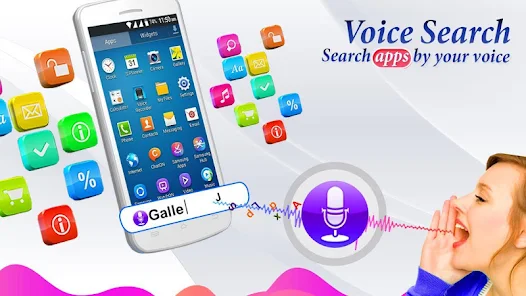In today’s fast-paced digital world, voice control technology has revolutionized how we interact with our smartphones. Android mobile voice control apps allow users to operate their devices hands-free, making tasks easier, faster, and more efficient.

Whether you’re multitasking, driving, or have limited mobility, voice-controlled apps enhance accessibility and convenience. In this comprehensive guide, we’ll explore the best Android voice control apps, their features, benefits, and how to use them effectively.
What is an Android Mobile Voice Control App?
An Android mobile voice control app is a software application that enables users to operate their smartphones using voice commands. These apps use speech recognition technology to perform tasks such as making calls, sending texts, opening apps, setting reminders, and even controlling smart home devices.
Popular examples include Google Assistant, Bixby, and third-party apps like Voice Access. These apps rely on AI and natural language processing (NLP) to understand and execute commands accurately.
Why Use a Voice Control App for Android?
Voice control apps offer numerous benefits, including:
1. Hands-Free Convenience
- Control your phone without touching it.
- Ideal for driving, cooking, or when your hands are occupied.
2. Enhanced Accessibility
- Helps users with disabilities (e.g., vision impairment or motor difficulties).
- Voice commands replace manual typing and navigation.
3. Faster Task Execution
- Quickly send messages, set alarms, or search the web by speaking.
- Reduces the time spent on manual inputs.
4. Smart Home Integration
- Control IoT devices like lights, thermostats, and security cameras.
- Works with Google Home, Alexa, and other smart ecosystems.
5. Improved Productivity
- Dictate notes, emails, and documents effortlessly.
- Schedule meetings and reminders with simple voice prompts.
Top 5 Android Mobile Voice Control Apps in 2024
1. Google Assistant
- Best for: General voice commands, smart home control, and Google ecosystem integration.
- Key Features:
- Voice search, reminders, and alarms.
- Works with Google Home devices.
- Supports multiple languages.
2. Bixby (Samsung Devices)
- Best for: Samsung users with deep device integration.
- Key Features:
- Controls Samsung apps and settings.
- Bixby Routines for automated tasks.
- Works offline for basic commands.
3. Voice Access by Google
- Best for: Accessibility and full device control.
- Key Features:
- Navigate apps, type, and scroll using voice.
- Designed for users with limited mobility.
- No internet required for basic functions.
4. Alexa (Amazon)
- Best for: Smart home control and Amazon services.
- Key Features:
- Controls Echo devices and compatible smart gadgets.
- Orders products from Amazon via voice.
- Supports skills for extended functionalities.
5. Speech Recognition & Voice Search
- Best for: Dictation and voice typing.
- Key Features:
- Converts speech to text in real time.
- Works with messaging and note-taking apps.
- Lightweight and fast processing.
How to Set Up a Voice Control App on Android
Step 1: Download the App
- Go to the Google Play Store and search for your preferred voice control app (e.g., Google Assistant, Voice Access).
- Tap Install and wait for the download to complete.
Step 2: Enable Permissions
- Open the app and grant necessary permissions (microphone, accessibility, notifications).
- For Voice Access, go to Settings > Accessibility > Voice Access and toggle it on.
Step 3: Train the Voice Model (If Required)
- Some apps may ask you to speak sample phrases for better recognition.
- Follow on-screen instructions to calibrate voice sensitivity.
Step 4: Start Using Voice Commands
- Activate the app by saying “Hey Google” (for Google Assistant) or tapping the mic icon.
- Try commands like:
- “Call Mom”
- “Send a WhatsApp message to John”
- “Turn on the living room lights”
Best Voice Commands to Try
Here are some useful voice commands for Android voice control apps:
| Category | Example Commands |
|---|---|
| Calls & Messages | “Call David on speaker”, “Send a text to Lisa: I’ll be late” |
| Media Control | “Play Spotify”, “Pause music”, “Next track” |
| Navigation | “Navigate to the nearest gas station”, “Open Google Maps” |
| Smart Home | “Turn off the bedroom lights”, “Set thermostat to 72 degrees” |
| Reminders & Alarms | “Set an alarm for 7 AM”, “Remind me to buy milk at 5 PM” |
| Web Search | “Search for Italian restaurants near me”, “What’s the weather today?” |
Tips to Improve Voice Recognition Accuracy
- Speak Clearly – Pronounce words naturally without rushing.
- Reduce Background Noise – Use voice commands in quiet environments.
- Update the App – Ensure you have the latest version for improved AI models.
- Retrain Voice Model – Some apps allow re-calibration for better accuracy.
- Use Wi-Fi or Strong Network – Cloud-based apps need a stable connection.
Future of Voice Control Technology
Voice control is evolving rapidly with advancements in AI and machine learning. Future trends include:
- More Natural Conversations – AI will understand context and emotions better.
- Offline Voice Processing – Faster response times without internet dependency.
- Multi-Language Support – Seamless switching between languages.
- Wider IoT Integration – Voice control for cars, wearables, and public systems.
Conclusion
Android mobile voice control apps are transforming smartphone usability, making daily tasks simpler and more efficient. From Google Assistant to specialized apps like Voice Access, these tools enhance productivity, accessibility, and smart home control.
By following this guide, you can choose the best voice control app for your needs, set it up correctly, and use voice commands like a pro. Embrace the power of voice technology and experience a hands-free, smarter Android experience today!